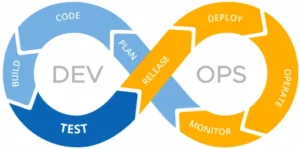Introduction
DevOps has become a culture for developing and implementing software in organizations. By defying the structural division between development and operation, it has become more efficient and much faster. However, once more, there is a transition occurring, and now the paradigm is platform engineering, which is the next stage in its development. So, how did we get here? Now, let’s discuss the evolution of DevOps and why platform engineering is moving to center stage.
The Origin of DevOps
The DevOps principle was developed around the middle of the 2000s when organizations realized that their software delivery process was too slow and uncoordinated. At that time, development and operation teams were usually separated, which caused shortcomings in interactive communications and feedback. These challenges reveal the necessity of a new approach, which implies cooperation between the two teams.
This is where DevOps was born, as a practice of creating solutions focused on automating the processes, shortening the development cycles, and reducing the gaps between the teams. It was proposed that by tearing down the walls between developers and IT, firms could release software of a higher standard faster.
Early Adoption and Growth of DevOps
DevOps in the first place took its roots from the IT or technology domains such as Amazon, where first and foremost was the swift delivery and considerably frequent updates to the presented software needed. These early adopters noticed significant positive impacts, including that feedback loops were achieved faster while software was more stable.
With the advancement of cloud computing, the practice of DevOps was made easier. Cloud offered the platform for automation of the deployment model and process management of work. Tweet: DevOps was a new phenomenon in the early 2010s, and its adoption had spread across industries as a means of enterprises’ competitiveness.
1. Cloud-Native Technology in Production
Cloud-native technology has arguably been one of the biggest sources of demand for DevOps. Microservices and containers as architectural foundations create advantages for organizations to build software and infrastructure faster and more adaptable, which can grow at will. Following the transition to cloud-native business applications, DevOps best practices are important for managing and supporting these intricate systems. Taking a DevOps course can equip professionals with the skills and knowledge to implement these best practices, optimize cloud-native processes, and enhance both the speed and reliability of software delivery.
That’s why the pandemic intensified this process, since many enterprises urgently shifted to working in the cloud to guarantee adaptability. The approach based on cloud-native technology and DevOps allows to deliver software and related changes quicker and cheaper, with fewer mistakes.
2. Integration of DevOps and Security
When organizations embraced the use of cloud technology, one of the major challenges that arose was security. Preparations for tests and security evaluation were normally done after the development phase, and this was greatly costly. Thus, while in traditional waterfalls the security is introduced in the middle of the development process, with DevOps security is from the onset. This is known as’shifting security left’—security issues are tackled early in the software development cycle.
There are many security risks in DevOps: security becomes an afterthought, with potential issues becoming worse and taking more cash to fix in the future if not addressed from the start. In the current world, teams collaborate with security specialists at every stage of development to design security into any project.
3. Testing Shifts Further Left
Implementing DevSecOps is not a completely new concept, as a way of shifting left is not only in security. Testing is also shifting upstream in the life cycle, meaning that errors will be identified and corrected earlier in the life cycle. One of the most important advantages of detecting bugs early is that it is also cheaper to fix bugs during development; it can cost up to $7600 times more to fix a bug during production.
Interestingly, more teams using shift-left testing also use continuous integration and delivery pipelines in their teams. Such testing and deployment automation enable code to be frequently in a state that is production-ready hence reducing on time wastage as well as instances of error.
State of DevOps

Surveys show that although DevOps has become quite popular, many businesses have not yet been able to reap the desired benefits from this practice. Despite the efforts in utilizing DevOps to dismantle some of the barriers between the development and operations’ entities, many teams struggle. These are: resistance to change, lack of right tools and difficultly in taking best practices to giant organizations.
However, the future of DevOps looks quite bright. With a key focus on Integrated Continuous Improvement, the teams are constantly refining how they go through their process in order to deliver better software more efficiently.
Bringing Development and IT Teams Together
Another benefit of the implementation of DevOps is that it unifies developers and IT operation employees. It used to be that these teams had distinct objectives; the development team worked on producing new capabilities while the IT operations team prioritized stability. This misger served to create bottlenecks and delays in the delivery of the software.
DevOps successfully resolved this problem through integration of the two teams. Currently there is a blurred line between development or IT professionals as they mostly use similar technologies to get things done. This has led to quicker releases and more stable systems than had been possible in the past.
Going Beyond Agile
Using agile methodologies made teams enhance their software development activities, but it did not solve the problem of separation of development and operation. DevOps extends the concept of the agile method by including automation of the delivering phase and feedback mechanisms.
With DevOps, teams can push code to production more frequently and with fewer issues. CI/CD pipelines automate much of the work, enabling teams to release updates multiple times a day instead of waiting weeks or months. This faster cycle is essential for companies looking to stay competitive in a rapidly evolving market.
Conclusion
DevOps has changed a lot over the course of the last few years and it has radically shifted the paradigm for how software is built and released. However, as any field evolves, it means that the methodologies in the tech field have to evolve as well as long as it is related to DevOps. That is why platform engineering is becoming the next level of this evolution that opens even more possibilities in improving control and productivity in software delivery for companies.
When DevOps is combined with platform engineering it enables businesses to take processes even further, create, deploy and maintain software at a faster paste, with enhanced security, and within minimal costs. DevOps is promising and has a long way to go and so does platform engineering.
FAQ
What is the evolution of DevOps?
DevOps has its origins back in mid 2000s to overcome the slow and rigid manner of software delivery. It has extended it to cloud-native technologies, security integration and early stage testing; and now, platform engineering is the subsequent trend emerging.
What is the history of DevOps?
DevOps emerged as a solution for a cumulative problem of software development process in which the development and operations teams were segregated. Lifting of these barriers by the DevOps made work to be in one team and it made the whole flow to be faster and more reliable.
What are the 7 phases of DevOps?
Most often, the 7 phases of DevOps are identified as planning, coding, building, testing, releasing, deploying, and monitoring.
What are the four basic stages of DevOps?
The four basic stages of DevOps are:
- Continuous Integration
- Continuous Testing
- Continuous Deployment
- Continuous Monitoring

